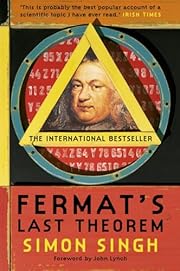

Fai clic su di un'immagine per andare a Google Ricerca Libri.
|
Sto caricando le informazioni... Fermat's Last Theorem: The Story Of A Riddle That Confounded The World's Greatest Minds For 358 Years (originale 1997; edizione 2002)di Simon Singh (Autore)
Informazioni sull'operaL'ultimo teorema di Fermat di Simon Singh (1997)

Sto caricando le informazioni...
Iscriviti per consentire a LibraryThing di scoprire se ti piacerà questo libro. Attualmente non vi sono conversazioni su questo libro. A fascinating read about attempts throughout the ages to conquer math's greatest puzzle finally solved by British mathematician, Andrew Wiles, in the late 20th century. Along the way we read about milestones, famous mathematicians, and are reminded of all that algebra we've since forgotten. Highly recommended and entertaining. “The definition of a good mathematical problem is the mathematics it generates rather than the problem itself.” Fermat's Last Theorem states that: xⁿ yⁿ = zⁿ has no whole number solutions for any integer n greater than 2. Simon Singh fashions the quest to solve this 350-year-old mathematical enigma into a compelling story. In the 1630s, when Pierre de Fermat scribbled a note on a page of his copy of Diophantus’s Arithmetica, stating (in Latin) his theorem and indicating “I have a truly marvelous demonstration of this proposition, which this margin is too narrow to contain.” Singh takes the reader through a series of minibiographies of past mathematicians, ultimately arriving at Andrew Wiles, who spent over eight years developing the 130-page proof. Along the way, the reader will learn a great deal about number theory, logic, and the rigorous standards required to achieve an absolute proof. This book covers a wide variety of people and their contributions over the years, such as Pythagoras, Leonhard Euler, Sophie Germain, Gabriel Lame’, Augustin Cauchy, Ernst Kummer, David Hilbert, Kurt Godel, Alan Turing, Goro Shimura, and Yutaka Taniyama. The highlight of the book is, of course, Andrew Wiles who discovered Fermat’s Last Theorem at the age of ten, and dedicated himself to figuring out a proof, no matter how long it took. Wiles decided to keep his work secret and work alone in his attic. “You might ask how could I devote an unlimited amount of time to a problem that might simply not be soluble. The answer is that I just loved working on this problem and I was obsessed. I enjoyed pitting my wits against it.” We learn about the Shimura-Taniyama conjecture, and the relationship between elliptic curves and modular forms. Singh never gets bogged down with calculations – they are instead included in the Appendices. I have a background in mathematics, so this type of subject matter appeals to me, but I daresay it is not required to enjoy this story of challenge, perseverance, and discovery. 4.5 Everything that a popular science book should be. It’s actually fast paced. I’m not even particularly interested in maths and it had me hooked. It tells the story of the theorem through a history of the mathematics that relate to it and there’s the inside story of the final proof and Wiles’ year of hell. What particularly impressed me was how Singh explained the maths. He keeps the notation to a minimum and has a particular way of introducing news ideas (you’ll see what I mean if you read it) so that even someone like me whose brain just doesn’t work that way can follow it. Quick to read, but must have taken ages to get right on the page. nessuna recensione | aggiungi una recensione
Appartiene alle Collane EditorialiPremi e riconoscimentiMenzioniElenchi di rilievo
Recognised as a classic of popular science writing, Fermat's Last Theorem is the story of a riddle that confounded the world's greatest minds for 358 years. Combining thrilling storytelling with a fascinating history of scientific discovery, Simon Singh tells how an Englishman, after years of secret toil, finally solved mathematics' most challenging problem. Non sono state trovate descrizioni di biblioteche |
Discussioni correntiNessunoCopertine popolari
 Google Books — Sto caricando le informazioni... Google Books — Sto caricando le informazioni...GeneriSistema Decimale Melvil (DDC)512.74Natural sciences and mathematics Mathematics Algebra Number theory Algebraic Number TheoryClassificazione LCVotoMedia: (4.09) (4.09)
Sei tu?Diventa un autore di LibraryThing. |
||||||||||||||||||||||||||||||||||||||||||||||||||||||||||||||||||||||||||||||||||||||||||||||||||||||||||||||||||||||||||||||||||||||
I enjoyed it as much as the first time around, though I'm pretty sure I was a lot quicker to finish this time around. I'm not gonna say I understood half of the math in the book, but I understood enough to keep up with the story. Mostly.
Even the things I don't understand are pretty cool to learn about. Shit like imaginary numbers and prime numbers (I like prime numbers: I once wrote a story titled Indiana Jones and the Exotic Prime Numbers) are pretty out there, but the different ways you can categorize numbers (friendly numbers! Perfect numbers! Vampire something numbers!) makes me like them even more. I kept telling Chriss about the things I was learning, but I don't think she found it as fascinating as me, but politely listened to what I had to say anyway.
Fermat sounded like he would've been a very annoying person to hang out with though.
(